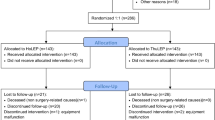Abstract
To evaluate the efficacy and safety of holmium laser enucleation of prostate (HoLEP) for treating urinary retention in patients with advanced prostate cancer. Thirty-eight cases of advanced prostate cancer with urinary retention were enrolled in this retrospective study. All the 38 patients were treated with CAB as a basis. Among them, 21 cases chose HoLEP additionally (HoLEP group). Seventeen cases stuck to CAB alone (CAB group). Serum PSA level, International Prostate Symptom Score (IPSS), quality of life score (QoLs), maximal flow rate (Qmax), and post-void residual volume (PVR) at 3, 6, 12, and 18 months after treatment were comparatively analyzed. The perioperative and postoperative parameters of HoLEP were assessed. Both groups demonstrated significant improvement in IPSS, QoLs, Qmax, and PVR during follow-up. But these parameters of HoLEP group improved more rapidly, significantly, and durably than CAB group. No serious complications were observed during and after HoLEP. PSA level of patients in both groups declined dramatically after surgery. But PSA in HoLEP group showed more dramatic and continuous drop. Besides, 1 of 21 patients in HoLEP group transferred into castration-resistant prostate cancer (CRPC) at 18th month of follow-up. While in CAB group, 5 of 17 patients developed into CRPC at 12th month of follow-up (P = 0.02 < 0.05). HoLEP was minimally invasive, safe, and effective, and could serve as a palliative approach to rapidly restore the patients’ urine and play a cytoreductive role in advanced PCa to improve the oncological prognosis.

Similar content being viewed by others
References
Bayne CE, Williams SB, Cooperberg MR et al (2016) Treatment of the primary tumor in metastatic prostate cancer: current concepts and future perspectives. Eur Urol 69(5):775–787
Chang CC, Kuo JY, Chen KK et al (2006) Transurethral prostatic resection for acute urinary retention in patients with prostate cancer. J Chin Med Assoc 69(1):21–25
Choueiri TK, Xie W, D'Amico AV et al (2009) Time to prostate-specific antigen nadir independently predicts overall survival in patients who have metastatic hormone-sensitive prostate cancer treated with androgen-deprivation therapy. Cancer 115(5):981–987
Crain DS, Amling CL, Kane CJ (2004) Palliative transurethral prostate resection for bladder outlet obstruction in patients with locally advanced prostate cancer. J Urol 171(2 Pt 1):668–671
Esper P, Redman BG (1999) Supportive care, pain management, and quality of life in advanced prostate cancer. Urol Clin North Am 26(2):375–389
Gilling PJ, Williams AK (2008) Holmium laser enucleation of the prostate is the single best treatment for benign prostatic hyperplasia refractory to medication. J Endourol 22(9):2113–2115
Greene FL, Page DL, FFleming ID et al (2002) Prostate. In: American Joint Committee on Cancer: AJCC Cancer Staging Manual, 6th edn. Springer, New York, pp 309–316
Guess HA (2001) Benign prostatic hyperplasia and prostate cancer. Epidemiol Rev 23(1):152–158
Heung YM, Walsh K, Sriprasad S et al (2000) The detection of prostate cells by the reverse transcription-polymerase chain reaction in the circulation of patients undergoing transurethral resection of the prostate. BJU Int 85(1):65–69
Khafagy R, Shackley D, Samuel J et al (2007) Complications arising in the final year of life in men dying from advanced prostate cancer. J Palliat Med 10(3):705–711
Li P, Wang C, Cao Q et al (2017) Prostatic arterial embolization followed by holmium laser enucleation of the prostate as a planned combined approach for extremely enlarged benign prostate hyperplasia. Urol Int 99(4):422–428
Mazur AW, Thompson IM (1991) Efficacy and morbidity of “channel” TURP. Urology 38(6):526–528
Michalak J, Tzou D, Funk J (2015) HoLEP: the gold standard for the surgical management of BPH in the 21(st) century. Am J Clin Exp Urol 3(1):36–42
Mommsen S, Petersen L (1994) Transurethral catheter removal after bilateral orchiectomy for prostatic carcinoma associated with acute urinary retention. Scand J Urol Nephrol 28(4):401–404
Moul JW, Davis R, Vaccaro JA et al (1989) Acute urinary retention associated with prostatic carcinoma. J Urol 141(6):1375–1377
Oefelein MG (2004) Prognostic significance of obstructive uropathy in advanced prostate cancer. Urology 63(6):1117–1121
Predina JD, Kapoor V, Judy BF et al (2012) Cytoreduction surgery reduces systemic myeloid suppressor cell populations and restores intratumoral immunotherapy effectiveness. J Hematol Oncol 5:34
Qin XJ, Ma CG, Ye DW et al (2012) Tumor cytoreduction results in better response to androgen ablation—a preliminary report of palliative transurethral resection of the prostate in metastatic hormone sensitive prostate cancer. Urol Oncol 30(2):145–149
Won AC, Gurney H, Marx G et al (2013) Primary treatment of the prostate improves local palliation in men who ultimately develop castrate-resistant prostate cancer. BJU Int 112(4):E250–E255
Funding
This work was supported by the National Natural Science Foundation of China (grant no. 81600514).
Author information
Authors and Affiliations
Contributions
Tang, Wang: performed the research
Li, Zhang: data collection or management
Qian: data analysis
Tang: manuscript writing/editing
Meng: project design and development
Corresponding author
Ethics declarations
Conflict of interest
The authors declare that they have no conflict of interest.
Ethical approval
This study was approved by the institutional review board of The First Affiliated Hospital of Nanjing Medical University (Nanjing, Jiangsu), and written informed consent was obtained from every participant.
Informed consent
All patients gave their informed consent prior to their inclusion in the study.
Additional information
Publisher’s note
Springer Nature remains neutral with regard to jurisdictional claims in published maps and institutional affiliations.
Rights and permissions
About this article
Cite this article
Tang, M., Wang, C., Li, P. et al. Efficacy and outcome of holmium laser enucleation of prostate in patients with urinary retention due to advanced prostate cancer. Lasers Med Sci 35, 1307–1313 (2020). https://doi.org/10.1007/s10103-019-02913-2
Received:
Accepted:
Published:
Issue Date:
DOI: https://doi.org/10.1007/s10103-019-02913-2




